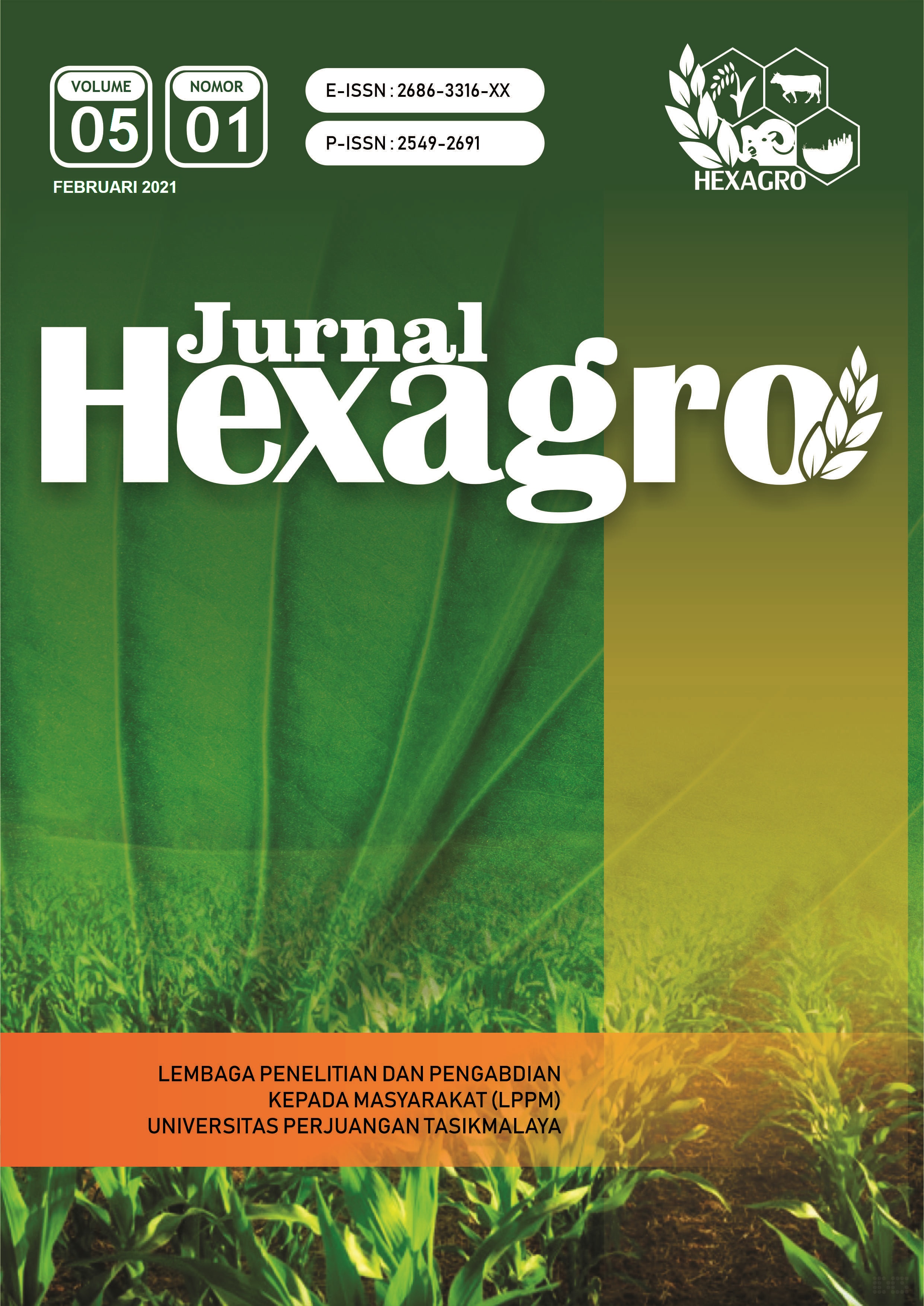ECONOMIC RETURN, YIELD AND HARVEST INDEX OF INTEGRATED NITROGEN IN 85,000 PLANTS Ha-1 ON Zea mays AGRIBUSINESS IN PESAWAR, PAKISTAN
DOI:
https://doi.org/10.36423/hexagro.v5i1.558Abstract
Zea mays is one of staple food for population in the world. The research aimed to determine economic return of integrated nitrogen and plant density. The research was conducted in RCB design having split plot arrangement comprising four replications. Plant density of Azam variety Maize were alloted to main plots (65000, 75000 and 85000 ha-1). Integrated nitrogen were assigned to sub-plots (control, 0% FYM + 100 % Urea, 100 % FYM + 0 % Urea, 50 % FYM + 50 % Urea, 75 % FYM + 25 % Urea and 25 % FYM + 75 % Urea). Data were recorded on plants harvest, harvest index, and benefit-cost ratio. The result showed plant density of 85.000 ha-1 among integrated nitrogen application of 50 % FYM along with 50% urea produced the highest B/C ratio (6.2). It is concluded that 50% FYM + 50% Urea along with plant population of 85000 plants ha-1 enhanced yield. Harvest index 33,4%, yield 4219.44 kgha-1. Total cost 36.961PKR, total income 227.941PKR economic net return 190.980PKR.References
Achieng, J., Ouma, G., Odhiambo, G., & Muyekho, F. (2010). Effect of farmyard manure and inorganic fertilizers on maize production on Alfisols and Ultisols in Kakamega, western Kenya. Agriculture and Biology Journal of North America, 1(4), 430–439. https://doi.org/10.5251/abjna.2010.1.4.430.439
Adeniyan, O. N., Aluko, O. A., Olanipekun, S. O., Olasoji, J. O., & Aduramigba-Modupe, V. O. (2014). Growth and Yield Performance of Cassava/Maize Intercrop Under Different Plant Population Density of Maize. Journal of Agricultural Science, 6(8). https://doi.org/10.5539/jas.v6n8p35
Ali, Q., Ali, A., Awan, M., Tariq, M., Ali, S., Samiullah, T., Azam, S., Din, S., Ahmad, M., & Sharif, N. (2014). Combining ability analysis for various physiological, grain yield and quality traits of Zea mays L. Life Sci J, 11(8s), 540–551.
Asbur, Y., Rahmawati, & Adlin, M. (2019). Respon pertumbuhan dan produksi tanaman jagung ( Zea mays L .) terhadap sistem tanam dan pemberian pupuk kandang sapi. Agriland, 7(1), 9–16. https://jurnal.uisu.ac.id/index.php/agriland/article/view/1243
Ashrafi, V., & Seiedi, M. N. (2011). Influence of Different Plant Densities and Plant Growth Promoting Rhizobacteria (Pgpr) on Yield and Yield Attributes of Corn (Zea Maize L.). Recent Research in Science and Technology, 3(1), 63–66. www.recent-science.com
Biba, M. A. (2015). Pengaruh Jarak Tanam dan Varietas Jagung Hibrida terhadap Pendapatan Petani. Prosiding Seminar Nasional Serealia, 745–750.
Cameron, K. C., Di, H. J., & Moir, J. L. (2013). Nitrogen losses from the soil_plant system_ a review -. Annal of Applied Biology, 162(2), 145–173. https://doi.org/https://doi.org/10.1111/aab.12014C
Cameron, R. W. F., Taylor, J. E., & Emmett, M. R. (2014). What’s “cool†in the world of green façades? How plant choice influences the cooling properties of green walls. Building and Environment. https://doi.org/10.1016/j.buildenv.2013.12.005
Cisse, A., Arshad, A., Wang, X., Yattara, F., & Hu, Y. (2019). Contrasting impacts of long-term application of biofertilizers and organic manure on grain yield of winter wheat in north China plain. Agronomy, 9(6). https://doi.org/10.3390/agronomy9060312
Dawadi, D. R., & Sah, S. K. (2012). Growth and Yield of Hybrid Maize ( Zea mays L .) in Relation to Planting Density and Nitrogen Levels during Winter Season in Nepal. 23(3), 218–227.
Duarte, S. R. (2007). Different Periods. Horticultura Brasileira, 154–158.
Hussain, H. A., Men, S., Hussain, S., Chen, Y., Ali, S., Zhang, S., Zhang, K., Li, Y., Xu, Q., Liao, C., & Wang, L. (2019). Interactive effects of drought and heat stresses on morpho-physiological attributes, yield, nutrient uptake and oxidative status in maize hybrids. Scientific Reports, 9(1), 1–12. https://doi.org/10.1038/s41598-019-40362-7
Kartika, T. (2018). Pengaruh Jarak Tanam terhadap Pertumbuhan dan Produksi Jagung (Zea Mays L) Non Hibrida di Lahan Balai Agro Teknologi Terpadu (ATP). Sainmatika: Jurnal Ilmiah Matematika Dan Ilmu Pengetahuan Alam, 15(2), 129. https://doi.org/10.31851/sainmatika.v15i2.2378
Khan, A., Zahir Afridi, M., Airf, M., Ali, S., & Muhammad, I. (2017). A Sustainable Approach toward Maize Production: Effectiveness of Farm Yard Manure and Urea N. Annals of Biological Sciences, 05(01), 7–13. https://doi.org/10.21767/2348-1927.1000103
Mamiev, D., Abaev, A., Tedeeva, A., Khokhoeva, N., & Tedeva, V. (2019). Use of green manure in organic farming. Xii International Scientific COnference on Agricultural Machinery Industry. https://doi.org/10.1088/1755-1315/403/1/012137
Pakistan Economic Survey. (2020). Finance Division Government of Pakistan.
Pakistan Government. (2020). Pakistan Economic Survey: Agriculture. In Pakistan Economic Survey (pp. 1–23).
Sangoi, L., Gracietti, M. A., Rampazzo, C., & Bianchetti, P. (2002). Response of Brazilian maize hybrids from different eras to changes in plant density. Field Crops Research, 79(1), 39–51. https://doi.org/10.1016/S0378-4290(02)00124-7
Sari, L. A. (2019). Pertumbuhan Hasil Jagung dan Kacang Tunggak dalam sistem Tumpangsari. 2011, 102–116.
Shamsabadi, H., Ahmad, D., Yahya, A., & Aimrun, W. (2017). Yield components of sweet corn (Zea mays) and some soil physical properties towards different tillage methods and plant population. Agricultural Engineering International: CIGR Journal, 19(3), 56–63.
Shi, D. yang, Li, Y. hong, Zhang, J. wang, Liu, P., Zhao, B., & Dong, S. ting. (2016). Increased plant density and reduced N rate lead to more grain yield and higher resource utilization in summer maize. Journal of Integrative Agriculture, 15(11), 2515–2528. https://doi.org/10.1016/S2095-3119(16)61355-2
Srivastava, R. K., Panda, R. K., Chakraborty, A., & Halder, D. (2018). Enhancing grain yield, biomass and nitrogen use efficiency of maize by varying sowing dates and nitrogen rate under rainfed and irrigated conditions. Field Crops Research, 221(March), 339–349. https://doi.org/10.1016/j.fcr.2017.06.019
Downloads
Published
How to Cite
Issue
Section
License
Copyright (c) 2021 Jurnal Hexagro

This work is licensed under a Creative Commons Attribution-ShareAlike 4.0 International License.
- Seluruh materi yang terdapat dalam situs ini dilindungi oleh undang-undang. Dilarang mengutip sebagian atau seluruh isi situs web ini untuk keperluan komersil tanpa persetujuan dewan penyunting jurnal ini.
- Apabila anda menemukan satu atau beberapa artikel yang terdapat dalam Jurnal HEXAGRO yang melanggar atau berpotensi melanggar hak cipta yang anda miliki, silahkan laporkan kepada kami, melalui email.
- Aspek legal formal terhadap akses setiap informasi dan artikel yang tercantum dalam situs jurnal ini mengacu pada ketentuan lisensi Creative Commons Attribution-ShareAlike (CC BY-SA).
- Semua Informasi yang terdapat di HEXAGRO bersifat akademik. Jurnal HEXAGRO tidak bertanggung jawab terhadap kerugian yang terjadi karana penyalah gunaan informasi dari situs ini.





